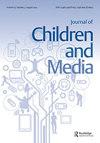Reassessing the risks: an updated content analysis of violence on U.S. children’s primetime television
IF 2.1
3区 心理学
Q2 COMMUNICATION
引用次数: 3
Abstract
ABSTRACT This study provides a comprehensive update investigating the amount and nature of violence contained in primetime television programming that targets children aged 17 and younger. Using the same sampling procedures and codebook as the original National Television Violence Study, we coded 765 primetime television programs airing on 21 broadcast and cable networks during the 2016/2017 season. We then separated children’s programs from nonchildren’s programs to compare violence by amount and context. Results indicate that programs targeted to youth continue to be more violent than programs made for adults, but the percentage of such programs was slightly lower than what was reported twenty years ago. Once again, violence in children’s programs is just as likely to be glamorized as shows for adults but continues to be more sanitized and trivialized. Implications for children’s learning of aggression are discussed. IMPACT SUMMARY Prior State of Knowledge: The landmark National Television Violence Studies (NTVS) found that violence is more prevalent in programs targeted to children. NTVS also found that violence in children’s programs was more likely to be sanitized and trivialized, increasing the risk of children’s learning of aggression. Novel Contributions: The study provides an important update to the media violence literature, and demonstrates that violence in children’s primetime television has not changed in any meaningful way in the last twenty years. Practical Implications: The patterns observed here heighten the risk of viewers learning of aggression and becoming desensitized to such portrayals. Future research should consider the intentions of those in the industry to better understand why violence remains a staple of children’s programming.重新评估风险:对美国儿童黄金时段电视节目暴力内容的最新分析
摘要:本研究对针对17岁及以下儿童的黄金时段电视节目中包含的暴力内容的数量和性质进行了全面的调查。使用与最初的全国电视暴力研究相同的抽样程序和代码本,我们对2016/2017赛季在21个广播和有线网络播出的765个黄金时段电视节目进行了编码。然后,我们将儿童节目与非儿童节目分开,通过数量和背景来比较暴力。结果表明,针对青少年的节目仍然比针对成人的节目更暴力,但这类节目的比例略低于20年前的报道。再一次,儿童节目中的暴力与成人节目一样可能被美化,但继续被消毒和轻视。讨论了对儿童攻击学习的启示。先前的认知状况:具有里程碑意义的国家电视暴力研究(ntv)发现,暴力在针对儿童的节目中更为普遍。ntv还发现,儿童节目中的暴力更有可能被消毒和淡化,增加了儿童学习攻击的风险。新颖贡献:该研究为媒体暴力文献提供了重要的更新,并证明了儿童黄金时段电视中的暴力在过去二十年中没有任何有意义的改变。实际意义:这里观察到的模式增加了观众学习侵略的风险,并对这种描绘变得不敏感。未来的研究应该考虑到业内人士的意图,以便更好地理解为什么暴力仍然是儿童节目的主要内容。
本文章由计算机程序翻译,如有差异,请以英文原文为准。
求助全文
约1分钟内获得全文
求助全文

 求助内容:
求助内容: 应助结果提醒方式:
应助结果提醒方式:


